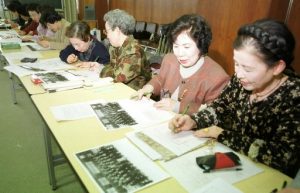Chugoku Shimbun’s survey verifies photos of 226 mobilized students of Hiroshima Municipal Girls’ School killed by the atomic bombing with cooperation from their surviving classmates
Feb. 28, 1999
School with largest death toll of students due to the atomic bombing
On February 27, the Chugoku Shimbun compiled a damage report after the atomic bombing of second-year students in six classes at Hiroshima First Municipal Girls’ School (present-day Funairi High School), which had the largest death toll of students from the atomic bombing in Hiroshima. Because their entrance photo taken at schools are still kept, they were identified with support from their classmates and surviving family member. Out of 264 second-year students who lost their lives due to the atomic bombing when mobilized to help with the demolition of buildings in the south zone of the present-day Peace Memorial Park located in Naka Ward, Hiroshima, 226 students in the photos were identified.
In late January, the first survey was conducted at the Chugoku Shimbun building with their classmates to understand how they were affected by the atomic bombing. Thirty former students came together for the survey from local Hiroshima, Osaka, Yamaguchi, and Fukuoka Prefectures.
The participants compared entrance photos taken for each class at school in April 1944, a year before the bombing, with documents like the list of victims at school created by the association of bereaved family members of A-bomb victims at the Municipal Girls’ School. In addition, based on the “The Student Attendance Record (made after the war disaster)” kept at Funairi High School, they tracked down the situation regarding how each of the students, who had been 13- or 14-year-old girls back then, experienced the atomic bombing.
As a result, the names of 289 out of the 310 students in the entrance photos were identified. Then, the photos of 224 students killed by the bombing were verified. Also, the photos of the other two deceased students, who were transferred from other schools after the entrance photos were taken, were provided by their surviving family members and classmates. Fifty-four students survived the bombing (two died last year) because they experienced the bombing at home, or had evacuated to the suburbs. The whereabouts of eleven classmates since after the bombing are still unknown because of their transfer to other schools in the chaotic period during or soon after the war, among other reasons.
From August 5, one day before the atomic bombing, first- and second-year students at the Municipal Girls’ School were mobilized to dismantle buildings in the former Nakajima district (the south part of the present-day Hiroshima Peace Memorial Park), the hypocenter of the bombing, to create fire lanes running east to west in the city, under the Student Labor Service Order issued by the Japanese government. Five hundred forty-one students perished in total. The first-year students, who enrolled at school in the final stages of war, did not take a class photo upon entrance.
Many of the survivors at school experienced the atomic bombing at locations other than the mobilization site, including their homes, because they had poor health on that day caused by food shortages at the time or because of previous demolition work done under the scorching sun. Some of them lost their parents, brothers or sisters due to the atomic bombing. However, as most of their classmates were killed when they took part in building demolition as mobilized students, they had refrained from attending the memorial ceremony and sharing their experience in public, feeling sorry to have survived, given feelings of their deceased classmates and their family.
The former students at the Municipal Girls’ School accepted an offer from the Chugoku Shimbun to get together for the first time in 54 years and identify their classmates, who had been killed by the atomic bombing. They said, “To leave proof of life of our classmates who died without experiencing peace is our duty as a person still alive. We would like young people to understand the reality of war and atomic bombing more to prevent such a tragedy from happening again.”
(Originally published on February 28, 1999)








